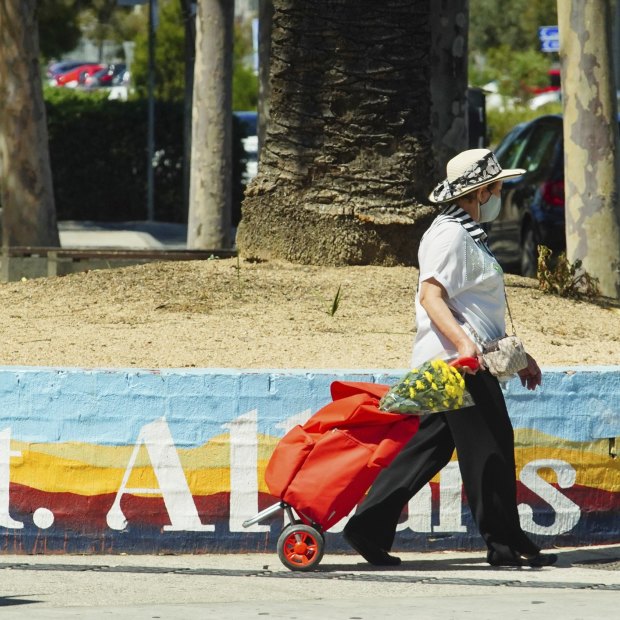
Alfrieda Street is the beating heart of St Albans.Credit: Luis Ascui
Nick Lo Presti calls St Albans Melbourne’s glistening jewel of the west. “I love being a Westie,” says the 53-year-old, who grew up in the area, and has been running St Albans Market since he was a teenager.
“Everyone works hard to get what they get in St Albans. They sacrifice not for themselves, but for their kids, for the next generation.”
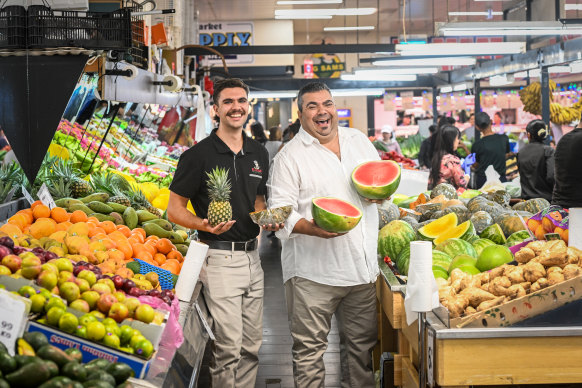
Nick Lo Presti and son PJ Lo Presti at the St Albans Market on Friday. Credit: Justin McManus
It is just after 10am on a sunny Tuesday in Alfrieda Street in St Albans, about 17 kilometres north-west of Melbourne’s central business district, and you could easily be mistaken for thinking you have suddenly been transported into the heart of Ho Chi Minh City in Vietnam.
Fruit and vegetable markets are brimming with ripe bananas and fuchsia-skinned dragon fruit, known as thanh long.
Nestled among bunches of vibrant Asian greens are bunches of blooming, yellow marigold flowers in buckets of water.
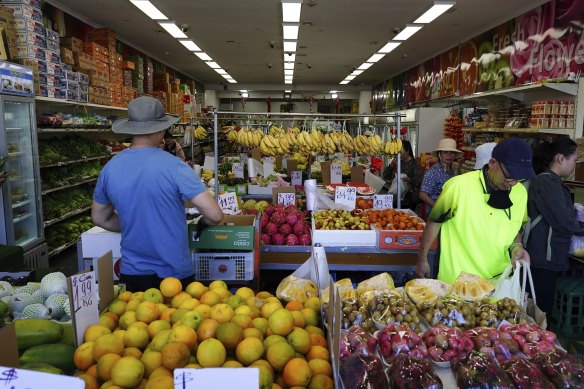
Customers shop at a Vietnamese grocer in St Albans. Credit: Luis Enrique Ascui
Crowds of people are sitting at tables outside sipping on Vietnamese coffees, while inside bakeries that dot the strip, staff are preparing for the lunchtime rush for banh mi.
They stack shelves with crusty white baguettes ready to fill with meat, pate, coriander, spring onion, cucumber, pickled carrot and chilli, while elderly Vietnamese residents set up outside, selling plastic water bottles filled with herbal tea from eskies packed with ice.
It is a world away from St Albans’ beginnings as a grazing farmland township in the 1830s, when fertile volcanic plains attracted European pastoralists and farmers to the area.
Soon after, land developer Alfred Padley is believed to have given St Albans its name after a town in Hertfordshire in England.
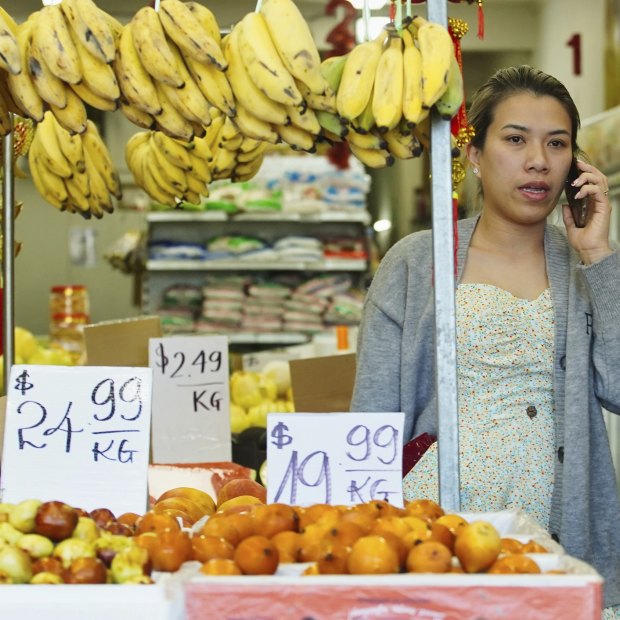
A Vietnamese fruit and vegetable market in St Albans.Credit: LUIS ENRIQUE ASCUI
St Albans’ growth has been driven by migration for generations, according to the Australian Bureau of Statistics, with just 39.4 per cent of residents born in Australia, compared to 66.9 per cent of residents across the country’s general population.
The age of the population is changing too, shifting from people over 60 to a predominantly younger population, aged between 20 and 39, according to the 2021 census.
Lo Presti, the son of Italian migrants, says you only have to step into the market, affectionately known as “Big Sam’s” (an acronym for St Albans Market) to see firsthand the fusion of cultures and languages in St Albans, which reflect the migration trends of Australia.
In the 1960s and ’70s it was a “mini Europe,” full of Italians, Greeks and Maltese families. Then came the migrants and refugees from the Balkans: the Serbs, Croatians, Macedonians, Albanians and Bosnians drawn from their war-ravaged homelands by affordable land and the promise of employment in nearby industries.
In the mid to late ’80s it was an influx of Vietnamese, and in the 90s a surge of families hailing from Africa, each arrival helping to cement the sense of local identity and community spirit that exists today.
“He [Big Sam’s] sort of shifts, changes and morphs with time to whatever his community wants and needs and that’s been so lovely to watch,” Lo Presti says, referring to the market as though it were a person.
Back in the 1960s and ’70s delis owned by Greeks, Italians and Polish traders filled the market. Now, there is only one Italian deli left, and Vietnamese grocers are flourishing.
More than a quarter of St Albans’ population has Vietnamese ancestry, but there are also large Maltese, Filipino and Croatian populations, with a growing number of Samoans, Indians and Punjabis moving to the area.
Among the dozens of stallholders in the market, boasting 50 different ethnic cultures, each with their own migrant story, is Bosnian refugee Azra Kurspahic.
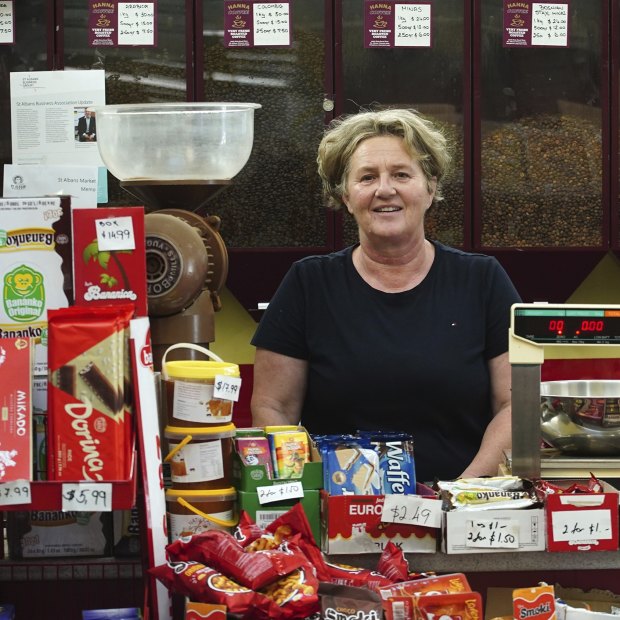
Big Sam’s Market stallholder Azra Kurspahic at her Hanna Coffee store, which sells Balkan specialities. Credit: Luis Enrique Ascui
She owns Hanna Coffee, specialising in eastern European and local coffees, specialty sweets including krempite (vanilla slices) and freshly baked bread.
Kurspahic, who migrated to Melbourne in 1995, says when she first opened her store in St Albans 16 years ago, it was full of Italian, Greek and Croatian shops.
Now, the market and Alfrieda Street is brimming with Vietnamese eateries and grocers. Kurspahic says her customers are a cultural melting pot hailing from Balkan, Italian, Maltese, Vietnamese, Chinese and African backgrounds to name a few.
“I love talking to people,” Kurspahic says. “I’m something like a therapist to all the locals.”
Kurspahic was drawn to open a store in St Albans because of its Bosnian population.
“People are so surprised when they come to St Albans,” she says.
“They have this perception it is dangerous or full of crime. It is never what they expect. That’s what I love about it. They keep coming back and back.”
Locals say labels, such as once being called the murder capital of Victoria due to a high rate of homicides for its small population, have stuck over the years.
In fact, data from the Crime Statistics Agency shows crime has declined in St Albans in the past four years, after peaking at almost 3400 incidents in 2020, before falling to 2812 incidents last year.
“The reality was there were few incidents that happened over the years here, but it is no more dangerous than anywhere else,” says Sebastian Agricola, who has worked as a solicitor at his practice in Alfrieda Street since the 1980s.
“It had a reputation as being a dangerous place of crime, but it was never really true or justified in my view, and so we’ve battled hard for many years to bring this place up.”
The suburb’s thriving foodie scene draws people from all over Australia and beyond. Culinary delights, such as Hanna Coffee, are making their mark at events such as the Melbourne Food and Wine Festival.
Alfrieda Street’s vibrant lunar new year celebrations also attract more than 80,000 people a year, even international television crews, including a South Korean news team, who flew down to document the event.
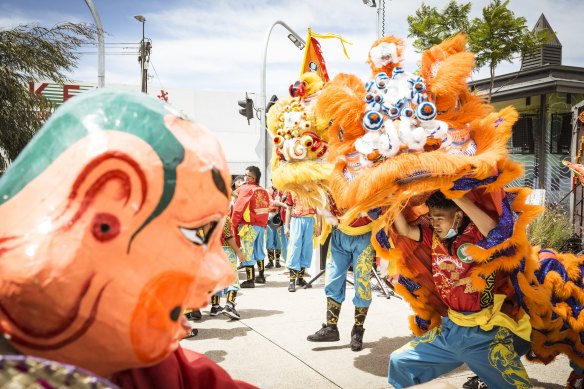
Lion Dance at the St Albans Lunar New Year Festival.Credit: Chris Hopkins
Agricola, who has served as its trader’s association president for more than two decades, calls St Albans the minestrone soup. A place where you can get a hair cut, colour and blow wave for just $70 or some of the best food in Melbourne.
“It is a mix of a lot of stuff and the ambience is just magnificent,” he says.
“But in 2014, a life-changing event occurred, and it has made the place what it is today.”
This event was the removal of the Main Road level crossing, linked to the deaths of a number of people, and deemed the most dangerous crossing in Melbourne, yet ignored by successive governments for decades.
The demolition of the Main Road level crossing, which locals describe as the knocking down of the Berlin war, came after years of community protests where residents and traders barricaded themselves to the train lines, and stormed the steps of parliament.
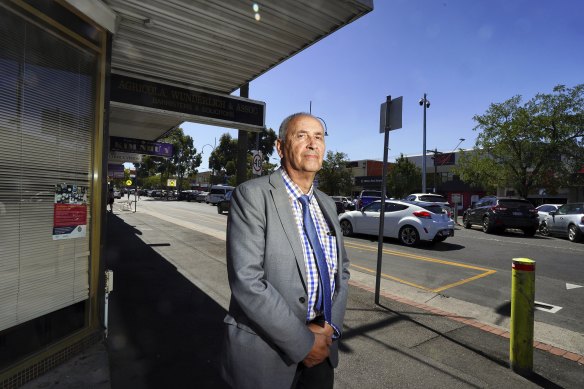
Sebastian Agricola says St Albans’ reputation as a crime capital is undeserved. Credit: Luis Enrique Ascui
“We were just a pain in the butt, and we never gave up,” Agricola says. “But that is the spirit of this community.”
Agricola pinpoints the removal of the level crossing, and the arrival of the Vietnamese community, as instrumental drivers in the transformation of the suburb, which has long been plagued by generational disadvantage.
“Suddenly people started to notice – hang on – you’ve got Victoria University here. You’ve got two hospitals and great schools and two freeways and can get into the city in less than half an hour,” he says.
“Try doing that from Boronia. We started to get an influx of different demographics flooding in.”
It is a trend being noticed by Binh “Benny” Nguyen, the director of O’Brien Real Estate, in St Albans.
He said when he started his job in 2001, you could snag a house in St Albans for $110,000.
“A decade ago my surname Nguyen was the most common name among homeowners,” says the real estate agent, who migrated to Melbourne’s western suburbs from Vietnam in 1985.
“During my high school days I was told St Albans was a place not to come. People just used to hang stuff on the west.
But it’s not the same any more, things have changed so much for the better.”
Now, the median price is about $650,000 and buyers are increasingly paying more than $800,000 for a house, or upwards of a million dollars for land ripe for development, Nguyen says.
Sleek modern townhouses are being built on subdivided blocks alongside old brick veneer and weatherboard houses that line the streets, while apartment buildings are sprouting up in land rezoned for high-density developments.
Nguyen says a changing demographic is also flooding to the suburb.
“A decade ago it was predominantly Asians,” Nguyen says. “Now we are getting all different cultures and young professionals.
“We’re seeing a lot more first home buyers coming because instead of buying a new apartment in the city, you can buy a house in St Albans.”
A projected population boom means change will only accelerate from here, but Agricola says St Albans locals remain passionately protective of their suburb’s character and grit; resistant to a full-blown gentrification of their home.
A recent council proposal to cut car parks along Alfrieda Street to make way for a boulevard in the strip was met with fierce opposition from locals.
“We said ‘hold on guys we aren’t the Champs-Élysées here’,” Agricola says.
“People come here for the hustle and bustle and the council, to their credit, listened to us.”
But change is still on its way. The Brimbank City Council has drawn up a 10-year strategic blueprint for the future of St Albans, paving the way for buildings of up to four storeys along the Alfrieda Street shopping strip and high-rises up to seven levels near the train station.
As Sunshine undergoes gentrification, the council has earmarked St Albans as ripe to emerge as an attractive alternative for affordable housing, drawing those seeking proximity to transport and amenities in Melbourne.
The council is also eyeing off more ways to establish greenery, trees and shaded spaces, less traffic congestion, better footpaths and cycling routes.
But as gentrification inevitably seeps into St Albans, pockets of anti-social behaviour remain, including a surge in illegal street vendors, who set up each day along Alfrieda Street, in a trend worsened amid the cost-of-living crisis.
On Tuesday afternoon, they were selling stolen stock including sirloin steaks and pork belly in eskies, as well as toothpaste and cosmetics hidden in foil-lined shopping bags.
Agricola says many of those selling the stolen goods caught the train into St Albans from different suburbs, often were part of organised crime groups and had spotters to evade police.
“It’s endemic. It’s persistent, and we want to get rid of it,” Agricola says. “It is a blight on the area, but police and the council are doing what they can.”
Current Brimbank councillor Virginia Tachos does not shy away from St Albans’ colourful past, nor the challenges still lingering.
But she says in the past decade the suburb has transformed into a lively and sought after foodie precinct, with a bustling arts culture, bolstered by the Bowery Theatre, inside the St Albans Community Centre.
The theatre, the legacy of a community bequest and council funding, is named after legendary Australian performer Leigh Bowery, an ’80s avant-garde artist who influenced Madonna, and hosts an eclectic mix of shows and exhibitions.
“Where else in Melbourne can you go to the theatre to see a show and then have a $10 bowl of the most delicious pho you have ever tasted?” Tachos asks.
Outside the community centre, colourful murals have been painted in laneways and on public walls, including one which takes pride of place over Errington Reserve, immortalising respected Brimbank indigenous elders Uncle Graham (Boots) and Aunty Joyce Cooper, in traditional possum skin cloaks.
But Tachos says more outreach services are urgently needed to tackle high rates of drug and alcohol addiction.
St Albans continues to have the fourth-highest rate of homelessness in the state, and its residents suffer catastrophic losses to pokies every year.
“People love the grittiness of St Albans and that it’s got this sense of chaos sometimes,” she says.
“There is more to be done to overcome the challenges it faces, but this suburb has come so far. It is full of so much heart and kindness.”
She says for every person doing it tough, there is a trader who will give them a free feed, or a food truck parked outside the community centre, ready to hand them a hot meal.
“In St Albans, it is less about judgment, and more about helping people,” Tachos says.
It is for this reason she often takes her young son to St Albans, so he can see the tales of migrant success, contrasted by the people down on their luck, struggling with addiction or sleeping rough.
“I say to him, this is real life; it’s not sanitised,” she says.
“There’s going to be people who fall through the cracks in life. We need to show compassion and support for those people.”